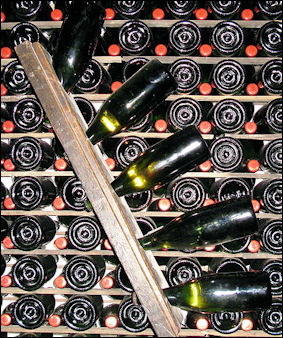WORLD’S TOP WINE CONSUMERS
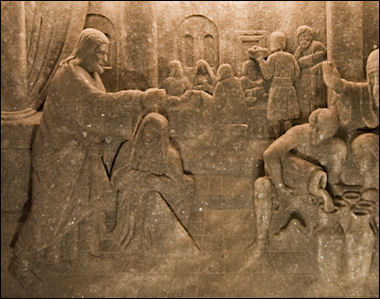
Jesus making Wine Top wine consumers (liters per capita): 1) France (60), 2) Italy (59.4), 3) Portugal (more than 50), 4) Luxembourg (more than 50). In contrast Americans only consume 7.7 liters and Japanese only 1.3 liters. 1996
World’s Top Importers of Wine (2020): 1) United Kingdom: 1456460 tonnes; 2) Germany: 1432041 tonnes; 3) United States: 1230992 tonnes; 4) France: 631651 tonnes; 5) Russia: 565030 tonnes; 6) Netherlands: 456605 tonnes; 7) Canada: 449873 tonnes; 8) China: 430222 tonnes; 9) Belgium: 333799 tonnes; 10) Portugal: 266430 tonnes; 11) Japan: 256090 tonnes; 12) Sweden: 213408 tonnes; 13) Denmark: 193947 tonnes; 14) Switzerland: 181439 tonnes; 15) Italy: 168547 tonnes; 16) Czechia: 153427 tonnes; 17) Brazil: 152074 tonnes; 18) Poland: 141309 tonnes; 19) Ireland: 127836 tonnes; 20) Australia: 121718 tonnes. [Source: FAOSTAT, Food and Agriculture Organization (U.N.), fao.org]
World’s Top Importers (in value terms) of Wine (2020): 1) United States: US$5883811,000; 2) United Kingdom: US$4439425,000; 3) Germany: US$2969334,000; 4) Canada: US$1979475,000; 5) China: US$1827244,000; 6) Japan: US$1557066,000; 7) Netherlands: US$1490968,000; 8) Switzerland: US$1234782,000; 9) Belgium: US$1135771,000; 10) Russia: US$1092002,000; 11) Hong Kong: US$968174,000; 12) France: US$863581,000; 13) Sweden: US$833106,000; 14) Denmark: US$768029,000; 15) Australia: US$625265,000; 16) Singapore: US$542948,000; 17) Norway: US$507775,000; 18) Brazil: US$438833,000; 19) Ireland: US$394008,000; 20) Poland: US$366408,000
Websites and Resources: Guardian & Observer Guide to Wine guardian.co.uk/lifeandstyle/page ; Wine Anorak wineanorak.com ; Wine Spectator winespectator.com ; Wine.com wine.com ; Wikipedia article Wikipedia ; Tesco Wine tesco.com/wine ; Wine Types wineintro.com/types/ ; Types of Wineslovetoknow.com/wiki/Category:Types_of_Wine ; Types of Wine Grapes frenchscout.com/types-of-wines ; History of Wine winepros.org/wine101/history ; Wikipedia article on History of Wine Wikipedia ; History of Wine Cornell University /rmc.library.cornell.edu/ewga/exhibition ; Winemaking wineintro.com/making ; Wine Producing madehow.com ;
Books: “Pocket Encyclopedia of Wine” by Hugh Johnson (Simon and Schuster) and “Oxford Companion to Wine” edited by Jancis Robinson (Oxford). Robert Parker, editor of the Wine Advocate, is author of several authoritative books on French wines.
World’s Top Wine Producing and Exporting Countries
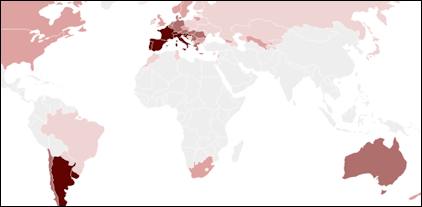
Wine consumption by country World’s Top Producers of Wine (2019): 1) Italy: 4922500 tonnes; 2) France: 4165524 tonnes; 3) Spain: 3370000 tonnes; 4) United States: 2583429 tonnes; 5) China: 2065561 tonnes; 6) Argentina: 1301947 tonnes; 7) Australia: 1197000 tonnes; 8) Chile: 1193876 tonnes; 9) South Africa: 973500 tonnes; 10) Portugal: 634885 tonnes; 11) Russia: 460000 tonnes; 12) Brazil: 378772 tonnes; 13) Hungary: 306200 tonnes; 14) New Zealand: 297400 tonnes; 15) Greece: 280336 tonnes; 16) Republic of Moldova: 182700 tonnes; 17) Georgia: 138060 tonnes; 18) Switzerland: 97945 tonnes; 19) North Macedonia: 90624 tonnes; 20) Japan: 82956 tonnes. [Source: FAOSTAT, Food and Agriculture Organization (U.N.), fao.org. A tonne (or metric ton) is a metric unit of mass equivalent to 1,000 kilograms (kgs) or 2,204.6 pounds (lbs). A ton is an imperial unit of mass equivalent to 1,016.047 kg or 2,240 lbs.]
World’s Top Exporters of Wine (2020): 1) Italy: 2061507 tonnes; 2) Spain: 2045869 tonnes; 3) France: 1418240 tonnes; 4) Chile: 849424 tonnes; 5) Australia: 761670 tonnes; 6) Argentina: 384270 tonnes; 7) United States: 363601 tonnes; 8) South Africa: 362327 tonnes; 9) Germany: 358600 tonnes; 10) Portugal: 315756 tonnes; 11) New Zealand: 307046 tonnes; 12) Canada: 165484 tonnes; 13) Republic of Moldova: 134162 tonnes; 14) Hungary: 107455 tonnes; 15) United Kingdom: 94484 tonnes; 16) Netherlands: 93481 tonnes; 17) Latvia: 88670 tonnes; 18) Austria: 70206 tonnes; 19) Georgia: 68775 tonnes; 20) Lithuania: 66681 tonnes
World’s Top Exporters (in value terms) of Wine (2020): 1) France: US$9935486,000; 2) Italy: US$7108242,000; 3) Spain: US$2999097,000; 4) Australia: US$2035083,000; 5) Chile: US$1816942,000; 6) United States: US$1310911,000; 7) New Zealand: US$1306097,000; 8) Germany: US$1034109,000; 9) Portugal: US$975924,000; 10) Argentina: US$775761,000; 11) United Kingdom: US$672380,000; 12) South Africa: US$622236,000; 13) Netherlands: US$454959,000; 14) Singapore: US$370223,000; 15) Latvia: US$284671,000; 16) Austria: US$226411,000; 17) Georgia: US$210314,000; 18) Lithuania: US$205376,000; 19) Denmark: US$204320,000; 20) Belgium: US$199959,000
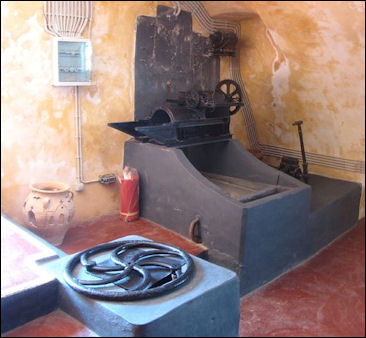
Old- fashioned wine-making
equipment in GreeceWorld’s Top Producers of Wine (2019): 1) Italy: 4922500 tonnes; 2) France: 4165524 tonnes; 3) Spain: 3370000 tonnes; 4) United States: 2583429 tonnes; 5) China: 2065561 tonnes; 6) Argentina: 1301947 tonnes; 7) Australia: 1197000 tonnes; 8) Chile: 1193876 tonnes; 9) South Africa: 973500 tonnes; 10) Portugal: 634885 tonnes; 11) Russia: 460000 tonnes; 12) Brazil: 378772 tonnes; 13) Hungary: 306200 tonnes; 14) New Zealand: 297400 tonnes; 15) Greece: 280336 tonnes; 16) Republic of Moldova: 182700 tonnes; 17) Georgia: 138060 tonnes; 18) Switzerland: 97945 tonnes; 19) North Macedonia: 90624 tonnes; 20) Japan: 82956 tonnes. [Source: FAOSTAT, Food and Agriculture Organization (U.N.), fao.org. A tonne (or metric ton) is a metric unit of mass equivalent to 1,000 kilograms (kgs) or 2,204.6 pounds (lbs). A ton is an imperial unit of mass equivalent to 1,016.047 kg or 2,240 lbs.]
World’s Top Exporters of Wine (2020): 1) Italy: 2061507 tonnes; 2) Spain: 2045869 tonnes; 3) France: 1418240 tonnes; 4) Chile: 849424 tonnes; 5) Australia: 761670 tonnes; 6) Argentina: 384270 tonnes; 7) United States: 363601 tonnes; 8) South Africa: 362327 tonnes; 9) Germany: 358600 tonnes; 10) Portugal: 315756 tonnes; 11) New Zealand: 307046 tonnes; 12) Canada: 165484 tonnes; 13) Republic of Moldova: 134162 tonnes; 14) Hungary: 107455 tonnes; 15) United Kingdom: 94484 tonnes; 16) Netherlands: 93481 tonnes; 17) Latvia: 88670 tonnes; 18) Austria: 70206 tonnes; 19) Georgia: 68775 tonnes; 20) Lithuania: 66681 tonnes
World’s Top Exporters (in value terms) of Wine (2020): 1) France: US$9935486,000; 2) Italy: US$7108242,000; 3) Spain: US$2999097,000; 4) Australia: US$2035083,000; 5) Chile: US$1816942,000; 6) United States: US$1310911,000; 7) New Zealand: US$1306097,000; 8) Germany: US$1034109,000; 9) Portugal: US$975924,000; 10) Argentina: US$775761,000; 11) United Kingdom: US$672380,000; 12) South Africa: US$622236,000; 13) Netherlands: US$454959,000; 14) Singapore: US$370223,000; 15) Latvia: US$284671,000; 16) Austria: US$226411,000; 17) Georgia: US$210314,000; 18) Lithuania: US$205376,000; 19) Denmark: US$204320,000; 20) Belgium: US$199959,000
The world's top wine producers in 1995 were (in hectoliters): 1) Italy (64 million), 2) France (50 million), 3) Germany (45 million) and 4) Spain (40 million). Countries that exported the most wine to the United States in 1996 were: 1) France; 2) Italy; 3) Chile; 4) Australia; 5) Spain; 6) Portugal; 7) Germany.
How Wine is Made
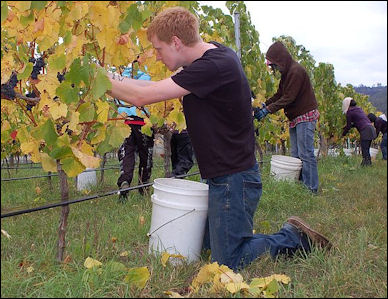
harvesting Pinot noir grapes
by hand in Australia In the old days when people knew little about making wine, they simply threw some crushed grapes in a bucket for a few days. After it had fermented, the stems, skins and seeds were filtered out and what remained was wine. [Source: Dick Rosano, Washington Post, December 13, 1995]
In the early 19th century Louis Pasteur discovered that the fermentation processes that changed grape juice into wine was primarily the work of microscopic fungi called yeast. Yeast cells are naturally found on grapes that are grown outdoors. When yeasts comes in contact with grape juice they consume it, and emit alcohol and carbon dioxide as waste. This process is known as fermentation.
During the process of fermentation yeasts multiply and cause other chemical changes. After this discovery, winemakers experimented with different kinds of yeasts to create different flavors and other desired characteristics. Natural yeasts were replaced with carefully selected strains that had different characteristics, such as tolerance to high and low temperatures, certain tastes, and subtle differences in the ways they produced alcohol. To inhibit the growth of undesirable micro-organisms, sulfur dioxide was added.
Modern wineries have elaborate systems with temperature monitoring devices and chemistry analyzers that regulate acidity and the sugar-to-alcohol process in a way that are designed to accentuate certain flavors and preserve the charter of fruit.
Harvesting and Crushing Grapes
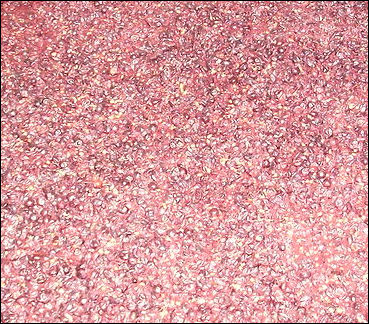
Crushed Pinot noir grapes
After grapes are harvested they are delivered to wineries in huge quantities. The timing of the harvest is important and weather conditions around the time of the harvest are crucial to determining the taste of a wine. An early harvest or a late harvest or a sudden frost or rain storm before the harvest can have a big impact on a wine.
It takes about 450,000 kilograms of grapes to produce 360,000 bottles of wine. Because large quantities are involved, most wineries have huge machines to crush the grapes. Portugal is one of the few places where the tradition of stamping grapes by foot persists.
Modern wineries use large trucks or trailers called gondolas that deliver the bunches of grapes that are usually picked by hand from the vineyards. The grapes are generally emptied into a machine that squeezes the fruit just enough to break the skin. In the old days, stems, skin and juice were fermented together. These days many commercial wineries have crusher-stemmers that remove the stems from the juice and pulp before fermentation. A 22 acre vineyard produces about 60,000 bottles of wine. The typical home of a small Burgundian wine maker has a barn-like ground floor for processing grapes; and living areas above reached by a staircase outside the home.
As a rule vineyards that have low yield produce top quality wine. "The lower the yield from the vinegar, the better yo can concentrate minerals, taste, flavor and aroma in the wine," one wine expert from Christie's told the International Herald Tribune.
Fermentation

The percentage of sugar found in grapes — typically called brix — is around 24 percent. During fermentation about half of the sugar becomes alcohol and the other half becomes carbon dioxide. This means that if all the sugar is fermented it would produce 12 percent alcohol.
Dry (non-sweet) wines have very little sugar left after the fermentation process. Sweet wines are fermented less and have more sugar left over.
After the grapes are crushed they are deposited in a large vat and mixed with a specialized yeast. During the fermentation the juice and pulp (known as "must") becomes a bubbling, hissing mass. Winemakers monitor the sugar content of the must with a device called a saccharometer and plot the data on a graph so that they can predict when the fermentation is finished and the sugar is used up. This is known in the wine business as "fermented out dry." The fermentation stops or slows down when the yeast runs out of sugar to eat.
In 1997, a Burgundy winemaker and his son died after falling into a vat of fermenting wine. It was not clear whether they drowned or were asphyxiated by carbon dioxide fumes.
Pressing and Aging
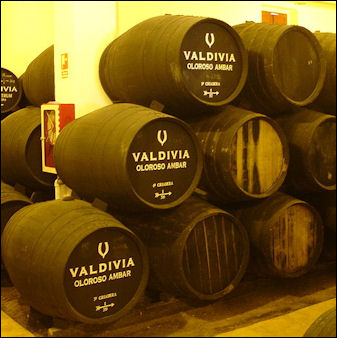
Aging barrels After the fermentation process is complete the "must" has been transformed to wine, which is then pumped through a basket press to separate the liquid from solids. Old presses used a downward-moving plate that squeezed the liquid through vertical wooden slats on the sides. Modern presses drains wine through a stainless steel basket.
The first wine to flow from the press — called "free-run" — usually has the most delicate and fruitiest taste. The remaining "press wine" is thicker, heartier and has a more full-bodied flavor.
After pressing the wine is transferred to some form of container for aging. Wine makers prefer to age wine the old fashion way: in wooden barrels because the woods give the wine a ceratin flavor. Storing wine in oak casks extracts tannin from the wood, adding to the wine's character. In the cellars of some wineries, wine makers use sulfur to burn off oxygen from oaken barrels in which wine is aged. Stainless steel barrels are used to preserve the freshness of wines that mature early. The aging process can take months or years.
During the aging process, the hundreds of chemicals in wine interact with one another in slow chemical reactions that reduce acidity and cause subtle variation in flavor that often can not be foreseen until the wine is tasted after the aging and bottling process are complete. Fine particles in the wine settle at the bottom of the barrel.
Racking and Bottling
racking the wine When the wine has settled, it is siphoned, or racked, from the storage containers into clean containers so that the wine is removed from impurities — such as dead or decaying yeast cells, decomposing grape skins — which can absorb unwanted flavors.
Most wines are racked several times. Gravity causes impurities to settle and racking removes the impurities producing a clearer wine each time the wine is racked. Many modern wineries have dispensed with the racking process and use filters to clean out the impurities.
When the wine has reached the desired clarity it is piped into a bottling room, where it is poured into sterilized bottles, fitted with a cork and wrapped in plastic, lead, wax or some other material. After bottling the wine can be aged further.
Wine is sometimes stored in temperature-controlled caves.
These days some wineries use computers and huge networks of pipes that direct the pressed grapes into stainless steel tanks used for fermenting and storage.
Wine Grapes

Grapes during pigmentation The most well-known wine grape varieties are: 1) Pinot Noir (used in red Burgundy and Champagne); 2) Cabernet Sauvignon, Cabernet Franc, Merlot and Malbec (all of which are used in making red Bordeaux); 3) Chardonnay and Aligoté (used in white Burgundy); and 4) Gamay grapes (used in Beaujolais).
Pinot Noir is oldest attested grape variety in Burgundy. It was referred toby the first century A.D. Roman writer Columella. Monks at the monastery in Cluny, the home of an abbey church only second in size to St. Peters in Rome, reportedly developed pinot noir and Chardonnay grapes.
Chardonnay grapes are considered one of the world's best wine-making grapes. It was thought for a long time that these grapes were a light skinned version of pinot noir. In 1999, scientist discovered that Chardonnay grapes are a cross between pinot and gouais, a variety of grapes considered so poor they are not even used in wine-making anymore.
Cabernet Sauvignon is perhaps the most esteemed red wine grape. It is a cross between the Cabernet Franc and Sauvignon Blanc grapes. Wines made from cross may not bear France's most prestigious label — "Appelation d' Origine Controlle." This slight seems to be somewhat outdated considering that some of the world’s best wines are made of Cabernet Sauvignon and Chardonnay grapes — both crosses.
 Muscadet wine is made from Melon de Bourgogne grapes. This white wine often comes from vineyards around Nantes, where the Loire empties into the Atlantic. It is dry and goes well with seafood. Melon grapes de Bourgogne produce dry white wines in Alsace and sweet wines elsewhere. Riesling, Traminer and Tokay grapes are used in white wines. Chenein Blanc wines are sweet; Cabernet Franc grapes are used in best rosé wines.
Muscadet wine is made from Melon de Bourgogne grapes. This white wine often comes from vineyards around Nantes, where the Loire empties into the Atlantic. It is dry and goes well with seafood. Melon grapes de Bourgogne produce dry white wines in Alsace and sweet wines elsewhere. Riesling, Traminer and Tokay grapes are used in white wines. Chenein Blanc wines are sweet; Cabernet Franc grapes are used in best rosé wines.
It the late 2000s Christopher Howe of Cambridge University and John Hager of Stanford University published a genetic study in which they showed that the original source of most of the strains of grapes used winemaking — such as Chardonnay, the source of Chablis, and gamay noir, the primary grape used to make Beaujolais — is the gouias blanc grape, a sour grape once so loathed by European aristocrats it was banned from winemaking. Both gouais blanc and pinot noir grapes were grown in the Middle Ages, with the former generally used to make poor quality wines and the latter used in high quality ones.
Conditions for Good and Bad Wine
Factors that influence the taste of a wine include grape variety, soil, climate, wine-making process, and the quality of the wine producers. Good wines comes from stressed vines produced in poor soil. The more stress, the more sugar. Soil is so important that few hundred yards of distance between soils can mean the difference between a good wine and a great one.
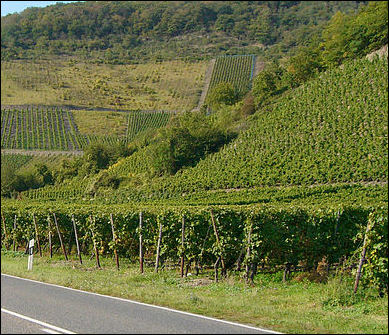
vineyard in Germany The best wines are often grown in dry climates with extremes temperatures shifts during the peak growing times. The combination of intense photosynthetic activity during the day and nocturnal rest brought by the abrupt temperature changes produces grapes with a color and aroma ideal for wine making. The taste improves in dry years.
Wine grapes grow best when there is an early spring and July and August are warm and sunny. The grapes are best when they come out early and change color early in the season. White wine grapes generally grow better in a cool, gray climates like that found in central Europe. Red wines grow better in hot sunny Mediterranean countries like that in Spain, Italy and France.
Wine specialist recognize 200 different basic combinations of grapes and soil that together with the wine making process, weather are the major factors in producing difference kinds of wines. The famous French chef Joel Robuchon told the Los Angeles Times, "California makes an excellent wine, and it is now becoming a very, very good wine. But it will perhaps never reach the level of French wine — even if we in France work less well. That is possibly because of climate and soil."
Factors that can destroy a crop of wine grapes include drought, insects, early frost, heavy rain at harvest time and hail form thunderstorms at any time. A bad hailstorm can reduce a harvest by 25 percent. In 1998 heat wave caused 20 percent of the grapevines in Bordeaux to wither.
Red, White, Sweet, Dry and Sparkling Wine
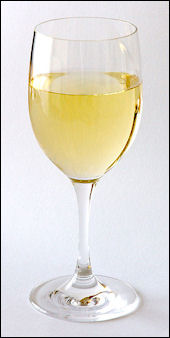 Red wine with beef. White wine with poultry, fish and seafood. Many people consider summer to be white wine season because red wine is considered to heavy to drink in hot weather.
Red wine with beef. White wine with poultry, fish and seafood. Many people consider summer to be white wine season because red wine is considered to heavy to drink in hot weather.
Red wine is made grapes that are mixed with the skins during fermentation. The juice itself doesn't have so much color, the skin is what gives red wine its red color. Red wine should be thick and is heavy.
White wines are made from grape juice that has been pressed before fermentation. White wine can be made from both white grapes and red grapes. The key factor is the skins are removed. Blance de blancs are white wines made with white grapes. Rose is made from red grapes in which the skins are ft on for a brief initial fermentations.
Dry (non-sweet) wines have very little sugar left after the fermentation process. Sweet wines are fermented less and have more sugar left over. The length of fermentation is one of the factors that determines whether or not a wine is sweet or dry. Wines that have been fermented for a long time tend to be dryers. Sparkling wines result when wine is bottled before the fermentation is complete and bubble-producing carbon dioxide is trapped within the wine.
Red Wine and Health
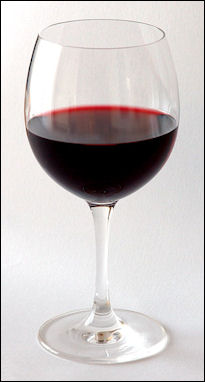
glass of red wine Red wine suddenlt came into vogue as a health drink after 1992 study showed a relation between the consumption of red wine and low rates of heart disease in France and hinted that red wine contained chemical that fought LDLs, the "bad chloresterol.” It also brought attention to the so-called French paradox: the fact that French can eat rich food high in saturated fat but avoid getting heat disease.
The Journal of Agriculture and Food Chemistry recommended the following wines for the cholesterol-fighting qualities: Petite Sirah '87, Merlot '90, Petit Sirah '89,Petite Sirah '90, Merlot 91, Cabernet Sauvignon '87, Zinfandel '90, Pinot Noir '92.
According to one study two or three glasses of wine a day reduces death rates from all causes by 3 percent. Five glasses of wine can cut the risk of heart attack.
Red wines, grape juice and grapes contains resveratrol, an antioxidant found largely in the skins of red grapes that reduced the incidence of skin tumors in mice by 88 percent according to one study. Studies with mice at Glasgow University indicate that red wine may combat inflammation and sepis, In the study researchers found that resveratrol protected mice exposed to a strong inflamation agent.
Antioxidants found in red wine, fruits and vegetables and tea counter the effects of free radicals — unstable, highly-reactive molecules — that attack human cells and tissues and have been linked to ageing and a range of ailments, including Parkinson’s disease, cancer and heart disease. Polyphenols are a kind of antioxidant found in red wine that have been shown to deactivate substances that help cancer grow and block the action of enzymes that cancers need for growth.
Studies have shown that drinking any kind of alcohol — beer, white wine and liquor — in moderation on a daily basis has the same health benefits of red wine and the overall benefits of drinking red wine are overstated anyway, and are comparable to benefits of eating nuts in moderation on a daily basis
Wine Tasting
When tasting wine one should hold the glass by the stem so as not warm the wine inside the glass. When wine tasters first taste wine they rotates a quarter-filled glass from side to side to note the wine’s texture, clarity and color. To discern its flavor they slosh the wine around a bit in their mouth, an act called "chewing." To get a good taste wine tasters slurp and gurgle the wine, warming and sending its aroma up the back channels to their nose, before swallowing it. To keep from getting drunk wine tasters spit the wine out after tasting it. [Source: Boyd Gibbons, National Geographic February 1992 [╒]
Some wine tasters say certain red wines remind them of berries and fruits, while whites emanate a fragrance like flowers. One wine taster told National Geographic, "Most of the identification of wine is in the nose, and the taste is only confirmation." [Source: Boyd Givens, National Geographic, September 1986 [┞]
Many of the best wines are made from a mixture of grapes. To get best results from good wine, it is sometimes recommended that you store it for a minimum of 10 years in your cellar before drinking it. Some wines, however deteriorate with age.
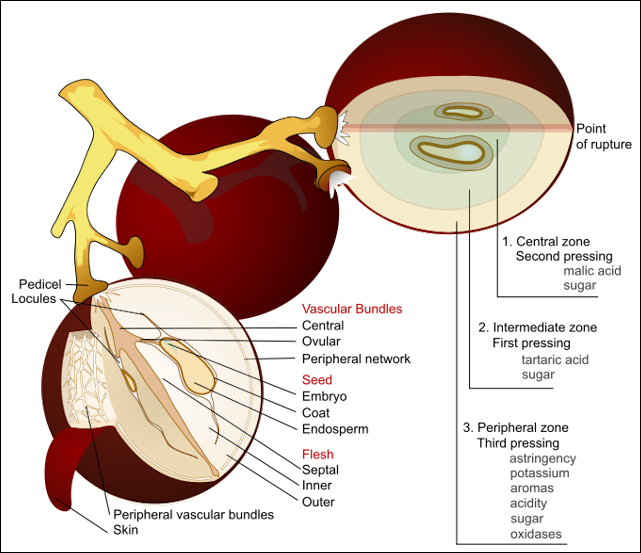
Wine grape diagram
Image Sources: Wikimedia Commons
Text Sources: National Geographic, New York Times, Washington Post, Los Angeles Times, Smithsonian magazine, Natural History magazine, Discover magazine, Times of London, The New Yorker, Time, Newsweek, Reuters, AP, AFP, Lonely Planet Guides, Compton’s Encyclopedia and various books and other publications.
Last updated March 2022

